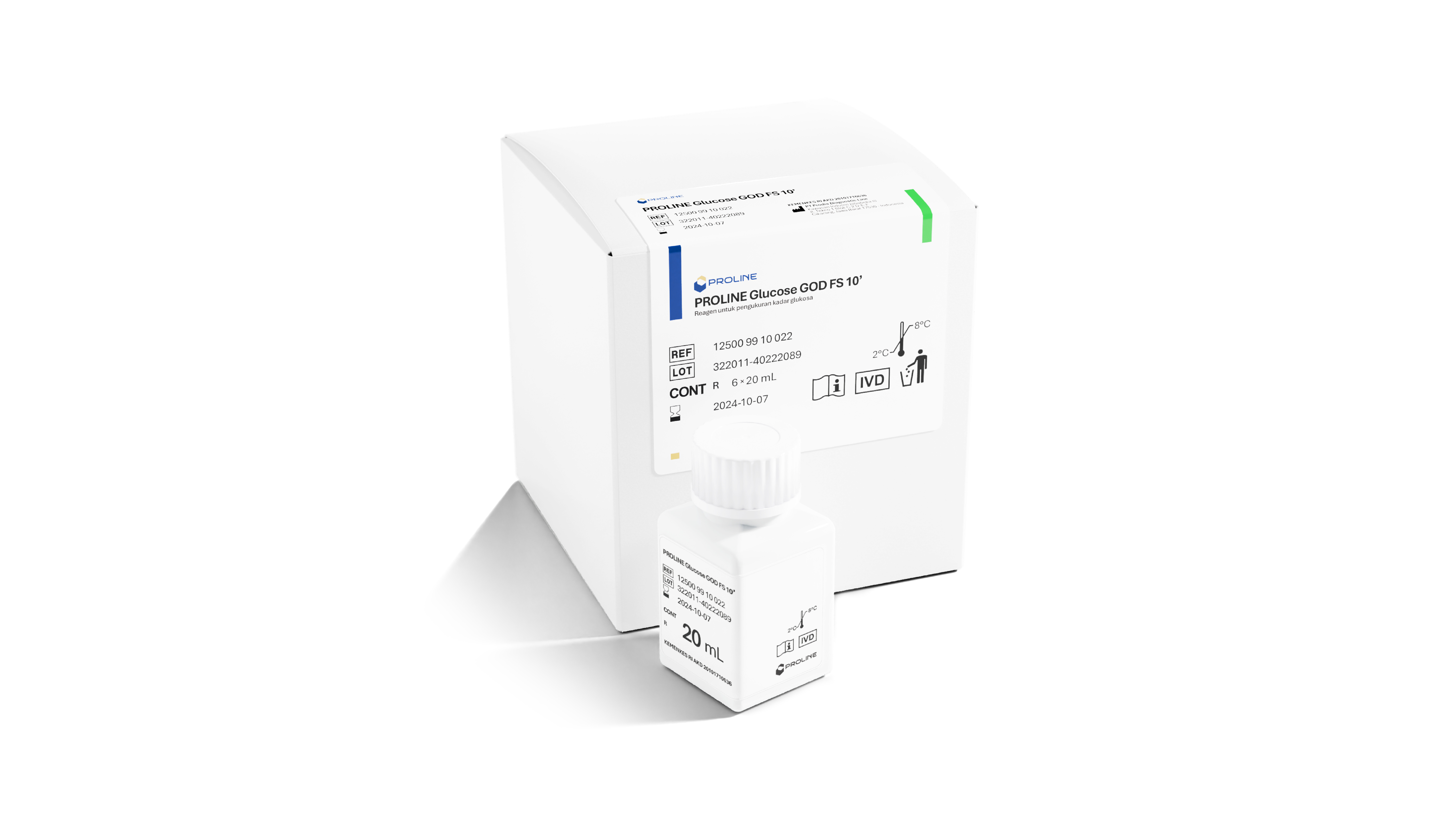PROLINE Glucose GOD FS 10’

| Catalogue Number | R1 Reagent Volume |
| 12500 99 10 923 | 4 x 43 mL |
| 12500 99 10 192 | 4 x 60 mL |
| 12500 99 10 182 | 4 x 60 mL |
| 12500 99 10 022 | 6 x 20 mL |
| 12500 99 10 025 | 4 x 80 mL |
| 12500 99 10 029 | 4 x 200 mL |
| 12500 99 10 961 | 6 x 25 mL |
| 12500 99 10 915 | 6 x 60 mL |
| 12500 99 10 952 | 6 x 40 mL |
| 12500 99 10 592 | 4 x 60 mL |
| 12500 99 10 027 | 4 x 62.5 mL |
A diagnostic reagent for the quantitative examination of glucose in human serum, heparin plasma, or urine in vitro using a photometric system.
Glucose is a monosaccharide (C₆H₁₂O₆) that serves as the body's primary energy source. Sugars from food are digested into monosaccharides such as fructose and galactose, which can form disaccharides or polysaccharides like starch and glycogen. Glucose metabolism involves processes such as glycolysis, glycogenesis, glycogenolysis, and gluconeogenesis, which are regulated by hormones. The oxidation of glucose through the Krebs cycle and the electron transport chain produces ATP as an energy source.
Blood glucose imbalances can lead to hyperglycemia (excess glucose) or hypoglycemia (low glucose). Prolonged hyperglycemia can cause diabetes mellitus, increasing the risk of complications such as heart disease and nerve damage. Conversely, hypoglycemia may result in weakness, dizziness, or loss of consciousness. Regular blood glucose monitoring is essential for preventing and managing these metabolic disorders.
Fasting blood glucose (FBG) and random blood glucose (RBG) tests are essential for assessing glycemic control and detecting diabetes. FBG is measured after ≥8 hours of fasting to evaluate baseline glucose levels, while RBG assesses the body's response to food intake. Normal FBG is <100 mg/dL, and normal RBG is <140 mg/dL; elevated levels may indicate prediabetes or diabetes mellitus. Regular testing is crucial for early diagnosis, therapy monitoring, and complication prevention.
Liver: Converts glucose into glycogen and vice versa.
Pancreas: Produces glucagon hormone.
Adrenal Glands: Regulates glucose levels through cortisol and epinephrine.
Thyroid Gland: Increases glucose levels via thyroxine.
Anterior Pituitary Gland: Increases glucose levels through adrenocorticotropic hormone (ACTH).
Insulin Hormone: Lowers glucose levels by increasing GLUT4 activity.
Glucagon Hormone: Increases glucose levels by stimulating glycogenolysis and gluconeogenesis.
Somatostatin Hormone: Lowers glucose levels alongside insulin.
Cortisol Hormone: Increases glucose levels by stimulating gluconeogenesis and antagonizing insulin.
Epinephrine Hormone: Increases glucose levels via glycogenolysis and fatty acid release from adipose tissue.
Thyroxine Hormone: Increases glucose levels through glycogenolysis and enhanced intestinal absorption.
Growth Hormone: Inhibits glucose uptake by the liver.
Adrenocorticotropic Hormone: Stimulates the adrenal glands to produce cortisol.
Enzymatic photometric assay with GOD-PAP.
- Ready-to-use liquid reagent (open-system) without reconstitution
- Excellent linearity and stability performance
- Available in MPK (Multi-Purpose Kit) and dedicated kit
- Compatible with >65 brands of manual and automated clinical chemistry analyzers
| Sample type | Human Serum and plasma heparin. |
| Measurement range | 0.43 mg/dL - 500 mg/dL |
| Analysis wavelength | 500 nm, Hg 546 nm |
| Analysis mode | End-Point |
| Reagent volume used (analyzer manual) | 1000 µL |
| Sample volume used (analyzer manual) | 10 µL |
| Storage temperature | 2 – 8 °C |
| Open vial stability | 18 months |
| Expiration date | 24 months |
| Control for Glucose Reagent | Calibrator for Glucose Reagent |
| TruLab N | TruCal U |
| TruLab P | Glucose Standard FS |
| Reference Range: | ||
| mg/dL | (mmol/L) | |
| Newborn | ||
| Umbilical cord blood | 63 – 158 | 3.5 – 8.8 |
| 1 hour | 36 – 99 | 2.0 – 5.5 |
| 2 hours | 36 – 89 | 2.2 – 4.9 |
| 5 - 14 hours | 34 – 77 | 1.9 – 4.3 |
| 20 - 28 hours | 46 – 81 | 2.6 – 4.5 |
| 44 - 52 hours | 48 – 79 | 2.7 – 4.4 |
| Children (Fasting) | 60 – 99 | 3.3 – 5.5 |
| Adults (Fasting) | ||
| Serum/Plasma | 60 – 95 | 3.3 – 5.3 |
- Glucose Reagent
- Doos
- Kit insert
- Reagents bottle
- PROLINE. PROLINE Glucose GOD FS Kit Insert [Update: 12500 01 – Sep 2024/03].
- Gurung P, Zubair M, Jialal I. Plasma Glucose. [Updated 2024 Feb 27]. In: StatPearls [Internet]. Treasure Island (FL): StatPearls Publishing; 2025 Jan-. DOI: https://www.ncbi.nlm.nih.gov/books/NBK541081/
- Eprilia V, Boy E. 2022. Pemeriksaan Kadar Gula Darah Untuk Screening Hiperglikemia Dan Hipoglikemia. Jurnal Implementa Husada. E-ISSN: 2722 - 0877. Vol. 3, No. 2, Hal. 65-71. DOI: https://doi.org/10.30596/jih.v3i2.11906
- Anggraini R, Nadatein I, Astuti P. 2020. Relationship of HbA1c with FastingBlood Glucose on Diagnostic Valuesand Lifestyle in Type II DiabetesMellitus Patients. Journal of MedicalLaboratory Science Technology. ISSN: 2580-7730. Vol. 3, Issue. 1, Hal. 5-11. DOI: https://doi.org/10.21070/medicra.v3i1.651
- Thomas L. Clinical Laboratory Diagnostics [Internet]. Prof. Lothar Thomas; 2020. DOI: https://www.clinical-laboratory-diagnostics.com/
- Hantzidiamantis PJ, Awosika AO, Lappin SL. Physiology, Glucose. [Updated 2024 Apr 30]. In: StatPearls [Internet]. Treasure Island (FL): StatPearls Publishing; 2025 Jan-. Available from: https://www.ncbi.nlm.nih.gov/books/NBK545201/
- Brochure : INA
- Diabetes
Contact our team to find out more product information and ordering
- Telp : +62 21 8984 2722
- WhatsApp : +62 815 1359 2626
- Email : marketing@proline.co.id
Contact our Technical support team for further assistance with product specifications, services and other technical documents.
- Telp : +62-21-8984-2722
- WhatsApp : +62-817-9324-884
- Email : technical.support@prodis.co.id
